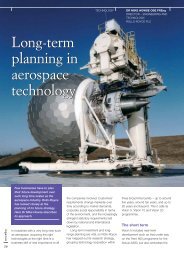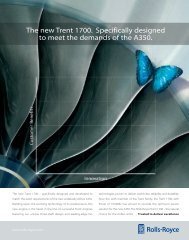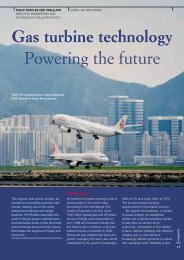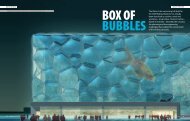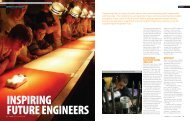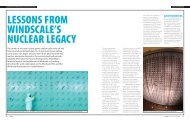Shipping safety - Ingenia
Shipping safety - Ingenia
Shipping safety - Ingenia
Create successful ePaper yourself
Turn your PDF publications into a flip-book with our unique Google optimized e-Paper software.
MARINE MATTERS<br />
ingenia<br />
18<br />
ship casualties. The underwater<br />
technology now exists for examining<br />
important shipwrecks at close quarters.<br />
A European Maritime Safety<br />
Agency<br />
There is a substantial loss of confidence<br />
in the shipping industry’s ability to<br />
regulate and then to implement.<br />
Moreover, it is essentially self regulating,<br />
which provides an in-built tendency to<br />
abuse the trust placed in it by<br />
governments and the public. It is<br />
therefore important that regulation<br />
should be undertaken by a truly<br />
independent body. Such a body for the<br />
aviation industry in the UK is the Civil<br />
Aviation Authority, ably supplied with<br />
feedback from the Air Accident<br />
Investigation Branch. (The UK already<br />
has a Marine Accident Investigation<br />
Branch as part of the Department of<br />
Transport.) The CAA is now being<br />
superseded by the European Joint<br />
Airworthiness Requirements.<br />
At the first European Parliamentary<br />
Symposium on Maritime Safety, on 24<br />
January 2002, it was suggested that an<br />
independent Maritime Safety Agency be<br />
established in Europe. Its terms of<br />
reference have yet to be agreed, but if it<br />
is to be styled on the European Joint<br />
Airworthiness Requirements then it will<br />
need ‘teeth’ to be able to influence and<br />
co-operate with IMO, IACS and the<br />
various ship class societies. This<br />
authority could come from the IMO, in<br />
which case provisional terms of<br />
reference and responsibilities for further<br />
discussion are suggested: to identify<br />
design, construction and maintenance<br />
areas where provision of technical<br />
<strong>safety</strong> is shown to be inadequate; to<br />
formulate or change corrective technical<br />
regulations and, when agreed, sample<br />
check that they are being properly<br />
implemented.<br />
This is naturally a delicate matter<br />
because it will, initially at least, be seen<br />
by IACS as undermining its authority.<br />
But, if the situation is properly handled,<br />
IACS should realise it is being assisted<br />
to do its job more effectively in the<br />
interests of shipping <strong>safety</strong><br />
internationally. This should then also<br />
answer much of the criticism which<br />
IACS at present suffers, and thereby<br />
strengthen its position.<br />
Legislating for human and operational<br />
weaknesses is a vast task requiring<br />
widespread efforts, but with the main<br />
thrusts coming from the IMO, owners<br />
and operators. Better technical feedback<br />
from sea, together with more resources,<br />
is needed for the MAIB to provide a<br />
more effective service worldwide.<br />
European funds could perhaps be<br />
forthcoming to build it into a European<br />
MAIB closely linked to the EMSA.<br />
Survival Design and ‘MaxWave’<br />
Because of insufficient forethought and<br />
testing, major accidents at sea in recent<br />
years have led to reactive modifications<br />
to the design of tankers, bulk carriers<br />
and ro–ro ships. It is abundantly evident<br />
that ships are not at present designed<br />
to have sufficient capability to survive<br />
the worst storms that nature can brew.<br />
This is quite contrary to the logical<br />
extreme ultimate limit state design<br />
approach as practised for naval, civil<br />
and aircraft structures. For example,<br />
William O’Neil points out that bridges<br />
are not built expecting that they will<br />
collapse if they are exposed to certain<br />
weather conditions.<br />
With this in mind, and following his<br />
work for the Derbyshire investigation,<br />
the author was invited by the World<br />
Meteorology Organization and others to<br />
present a keynote address to the<br />
metocean community on what naval<br />
architects needed in terms of extreme<br />
wave measurements from satellites and<br />
other remote sensing devices. This led<br />
in December 2000 to a three year,<br />
4.65 million euros European research<br />
programme, ‘MaxWave’, comprising<br />
ten projects in six countries. Already the<br />
programme is providing better data on<br />
the characteristics of waves in extreme<br />
storms. The first year’s evidence shows<br />
that very large waves do occur with<br />
wave heights of 2.3 to 2.5 times the<br />
significant wave height (H s<br />
), and one<br />
was 2.9 H s<br />
. These far exceed the<br />
smaller linear waves used at present in<br />
Some abbreviations<br />
AAIB Air Accident Investigation<br />
Branch<br />
CAA Civil Aviation Authority<br />
EMAS European Maritime Safety<br />
Agency<br />
FSA Formal Safety Assessment<br />
IACS International Association of<br />
Classification Societies<br />
ICONS International Commission on<br />
<strong>Shipping</strong><br />
IMO International Maritime<br />
Organization<br />
ISM International Safety<br />
Management<br />
JAR (European) Joint<br />
Airworthiness Requirements<br />
MAIB Marine Accident<br />
Investigation Branch<br />
SOLAS <strong>safety</strong> of life at sea<br />
STCW Standards of Training,<br />
Certification &<br />
Watchkeeping<br />
SWATH small waterplane area twin<br />
hull<br />
TEU 20 foot equivalent units<br />
design. These data, together with<br />
evidence of losses and near misses<br />
from ships at sea mentioned earlier, will<br />
surely provide the need for survival<br />
design. Moreover, corresponding critical<br />
ship conditions are being identified and<br />
there is now little doubt that ships can<br />
be designed with relatively low first cost<br />
penalty to withstand most of the effects<br />
of abnormal waves, thereby saving lives<br />
and property at sea.<br />
Survival Design illustrated<br />
The most important step in a first<br />
generation survival design approach is<br />
to determine the characteristics of the<br />
most likely damaging survival wave or<br />
sequence of waves for the mode of<br />
ship loss being considered. For<br />
example, to estimate the survival design<br />
forces on forward cargo hatch covers<br />
and their side coamings in bulk carriers<br />
the following procedure, based on the<br />
Derbyshire research, has been<br />
recommended:



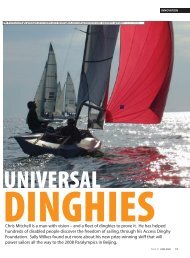

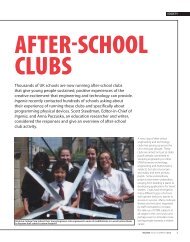
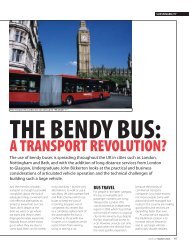
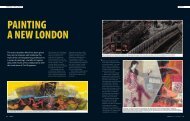
![[322/03] Francke - Ingenia](https://img.yumpu.com/23411337/1/184x260/322-03-francke-ingenia.jpg?quality=85)

